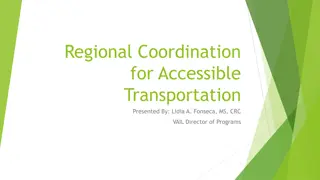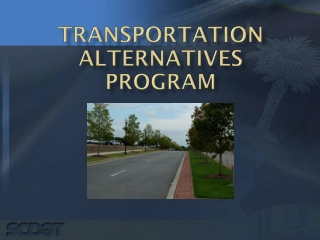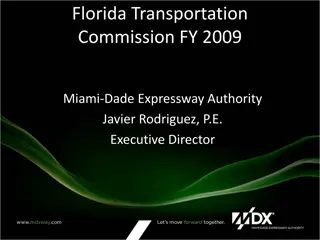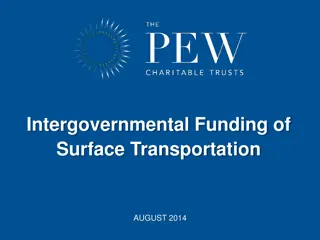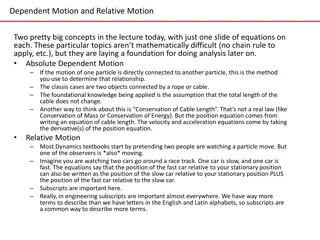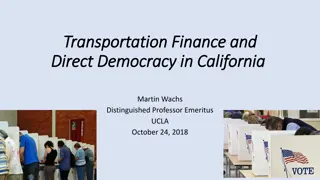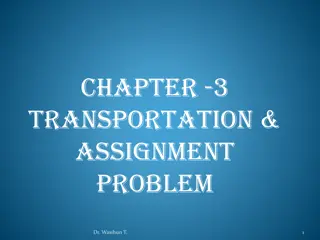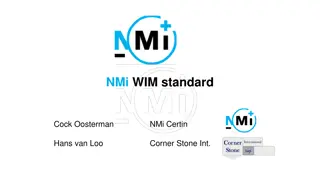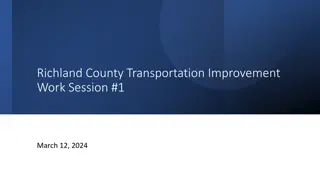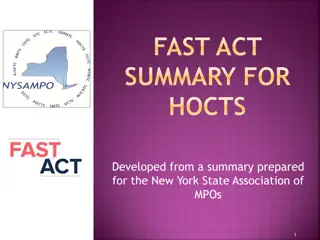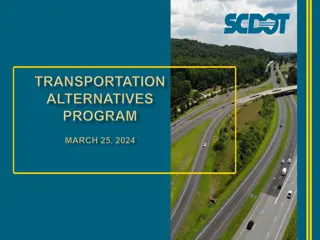Understanding Tolling Theory in Motion for Transportation Funding
Explore the practice of tolling as a key strategy for generating capital in transportation infrastructure projects. Discover the importance of toll feasibility assessment, traffic management, and revenue generation. Learn about current funding challenges in transportation and innovative financing methods used in toll projects across the United States.
Download Presentation

Please find below an Image/Link to download the presentation.
The content on the website is provided AS IS for your information and personal use only. It may not be sold, licensed, or shared on other websites without obtaining consent from the author. Download presentation by click this link. If you encounter any issues during the download, it is possible that the publisher has removed the file from their server.
E N D
Presentation Transcript
THE PRACTICE OF TOLLING Theory in Motion Michael Copeland Yagnesh Jarmarwala Justin Winn May 7, 2013
Agenda Introduction Need for tolling Generating Capital Funding and financing Credit enhancement Assessing Toll Feasibility Traffic and revenue Costs Financial analysis Toll rate policies Recent Toll Projects in the US Conclusions 2
The Practice of Tolling: INTRODUCTION 3
Current State of Transportation Funding Two primary funding sources for roads Taxes Tolls and other fees Buying power of fuel taxes decreasing Not indexed to inflation Increased fuel efficiency There are no free roads $0.020 1.8 Gas tax indexed for inflation Gas Tax Revenue Per Mile (2010$) No gas tax increase $0.016 $0.012 0.9 $0.008 $0.004 0.3 $0.000 2010 2020 2030 2040 2050 4
Tolling in the United States States with Toll Facilities States without Toll Facilities 5
Uses of Tolling Revenue generation to support Construction Operations Maintenance Traffic management Optimization of available capacity Management of peak period trips 6
The Practice of Tolling: GENERATING CAPITAL 7
Funding Sources and Financing Methods Tolling may not provide sufficient revenue for financing Options State tax funds Federal tax funds Innovative financing methods Examples Maryland ICC Triangle Expressway 8
Innovative Financings Toll State- backed Bonds, 29.3% Toll Revenue Bonds, 22.7% Federal Funds, 31.9% Revenue Bonds, 29.1% State Funds, 15.0% TIFIA Loan, 33.0% TIFIA Loan, 21.0% State Funds, 18.1% Intercounty Connector 50.1% of total financing backed by toll revenue Triangle Expressway 55.7% of total financing backed by toll revenue 9
Credit Enhancement Leveraging additional resources Future tax revenue Future revenue of existing toll facilities Examples Sam Rayburn Tollway Financed based on the combined revenue potential of both SRT and 60+ additional miles of NTTA toll facilities President George Bush Turnpike Western Extension Toll equity loan agreement Advantages Financing may not be otherwise feasible Better bond ratings and interest rates 10
The Practice of Tolling: ASSESSING TOLL FEASIBILITY 11
Toll Facility Development Overview How do we know how much money we can generate from tolling? Traffic and Revenue Projection Process Can we generate enough money to make tolling worthwhile? Feasibility Assessment If we can generate enough money, how do we finance it? Project Financing 12
Elements of a Feasibility Study Project Cost Evaluation Traffic and Revenue Tolling Feasibility General Financial Analysis 13
Traffic and Revenue: Key Questions What is the overall travel demand in the corridor? How much will it grow in the future? What share of the demand can be expected to use the new facility? How much will users be willing to pay? Types of studies Sketch level Preliminary Investment Grade Confidence Range Investment Grade Sketch Preliminary 14
Project Cost Evaluation Construction costs Maintenance costs Operations costs Examples Pre-Construction Construction Post-Construction Traffic and Revenue Financial Analysis Environmental Assessment Design Construction Tolling Technology Customer Service Center Transaction Processing Office Customer Service Roadway Maintenance Equipment Maintenance Toll Collection/Processing Violations Processing Incident Management 15
Financial Coverage Ability for project to meet financial obligations Components impacting financial coverage Costs Capital Operations Maintenance Debt (borrowing) Revenue Traffic Toll rates Leakage Fees and fines Other investment revenue Does the project pay for itself? $250.00 $200.00 Annual Revenue ($) $150.00 $100.00 $50.00 $0.00 Year 16
Toll Rate Policies Toll rate increase options As needed to fulfill debt obligation Planned periodic increases Could strengthen revenue outlook Removal of tolls After debt retirement, removal of tolls from the facility may be proposed Operation and maintenance costs should be considered, particularly for aging roadways Toll removal may be short-term benefit and long-term liability Annual Revenue ($) Year 17
The Practice of Tolling : RECENT TOLL PROJECTS 18
Sam Rayburn Tollway Dallas-Fort Worth, Texas 26-mile, all-electronic toll road in Dallas northern suburbs Originally pursued as a private concession Met with public and political resistance Awarded to NTTA for a $3.2 billion upfront payment Financed as part of the 90+ mile NTTA System 19
Intercounty Connector Maryland Collaborative development between Maryland Transportation Authority and Maryland State Highway Authority Opened in 2011 as all- electronic toll road Operated for one week without tolls for patrons to try out the road Multiple financing methods GARVEE bonds, TIFIA loan, toll revenue bonds Leveraged entire MdTA system 20
Triangle Expressway Raleigh-Durham, North Carolina 18.8-miles Two phases Triangle Parkway (opened December 2011) Western Wake Freeway (under construction) All-electronic toll collection Multiple financing methods Toll revenue bonds, TIFIA loan, bonds backed by state tax revenue, additional state funds 21
The Practice of Tolling: CONCLUSIONS/RECOMMENDATIONS 22
Conclusions/Recommendations Tolling has proven to be an effective funding source for new highway capacity as state and federal tax revenues diminish In many cases, however, tolling cannot support the entire cost of projects Must be supplemented with alternative funding sources Risk management Demographic growth Financial coverage Public opinion Consideration of all options, not just tolling, may yield a more sustainable finance plan Method of evaluating potential toll projects is needed 23









